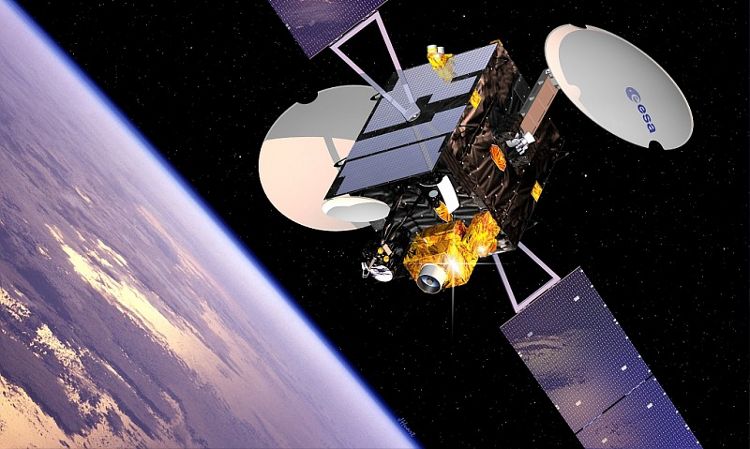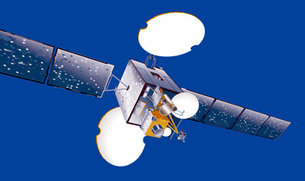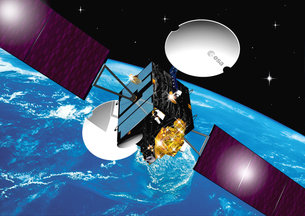Artemis (satellite)
Artemis is a European- Japanese geostationary communications satellite, the European Space Agency operates (ESA). Artemis stands for Advanced Relay and Technology Mission ( about: advanced relay and technology mission). Features were experimental optical data links ( Laser Communication Terminal ), two kinds of advanced ion engines and a flexible operating software. Regularly build Artemis and the French reconnaissance satellite spot 4 a laser data connection ( SILEX ). Similarly, the tests with the Japanese research satellite Kirari were successful. An optical data link to aircraft ( LOLA ), drones and ground stations were tested. His operational responsibilities include communication with Envisat and utility vehicles such as ATV -4 as well as the broadcast of the GPS correction signals from EGNOS.
The satellite had a launch mass of 3,100 kilograms. Its useful electrical power is 2.8 kW. He started on 12 July 2001 together with the Japanese communications satellite BSAT 2b onboard an Ariane 5G.
Rescue with ion thrusters
The launcher should bring the satellite into a geostationary transfer orbit, but reached its full power not so that the apogee was only 17,000 instead of 36,000 km. BSAT 2b was lost, but Artemis could be saved. The apogee of the satellite was actually intended also to raise the perigee to 36,000 km altitude. For this and for the use of the position control Artemis had to reach 1500 kg of fuel and oxidizer on board, which is now 95 % were employed at least one circular orbit at 31,000 km altitude. In this parking orbit, outside the dangerous Van Allen Belt, the position control of Artemis was reprogrammed so that a pair of ion engines could propel the satellite into geostationary orbit. The spiral ascent at about 20 km a day lasted from February to November 2002. His final position at 21.5 ° Ost021.5 Artemis reached in March 2003.
Ion thrusters
Artemis was designed to test two new ion engines: a German product electrodeless, microwave- excited discharge ( see microwave lamp ) and 15 mN thrust, as well as an English product with Electro- bombardment (Kaufmann? ) Source and 18 mN thrust. For comparison, Artemis has 16 chemical attitude control thrusters with 10 N thrust. From both types of ion thruster two were used, mounted on the north and south sides of the satellite in mixed pairs. Your job should the correction of perturbations in geostationary orbit be (inclination only ). The electrical performance of a pair of 600 W. As a supporting mass xenon is used. The common stock was only 40 kg. Instead of nominally 30 km / s exit velocity 40 km / s: For this amount is sufficient for the salvation of the satellite and its impending transfer to the cemetery, the engines were operated at maximum acceleration voltage
To save xenon, the north-south drift is not compensated. The longitude of 21.5 ° East is maintained approximately by means of chemical control nozzles. At present, the inclination is about 10 °, so that the satellite is no longer stationary over the equator, but a narrow Analemma trajectory describes the sky ( see illustration ).
Payload
Artemis communicates on the following bands:
- L-band ( 1.6 GHz send receive to / from ground station ) Send: 15 channels
- Received: 6 channels
- A total of 400 voice channels, each with 4.8 kbits / sec
- Send: 3 Mbps
- Receive: 1 Mbps
- Send: 1 Mbps
- Receiving: 3 Mbps
- Send: up to 150 Mbps
- Receiving: 10 Mbps
- Send: 10 Mbps
- Receiving: up to 3 x 150 Mbps
- Send: 2 Mbps
- Receiving: 50 Mbps
So that the following data rate from a satellite to a ground station Artemis is possible:









